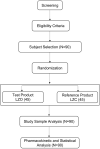Superior Bioavailability of a Novel Lutein and Zeaxanthin Formulation in Healthy Human Subjects
- PMID: 35585428
- PMCID: PMC9253220
- DOI: 10.1007/s40123-022-00522-x
Superior Bioavailability of a Novel Lutein and Zeaxanthin Formulation in Healthy Human Subjects
Abstract
Introduction: Lutein (L) and zeaxanthin (Z) are carotenoids that are found in the macula of the human eye and are known to improve visual functions. However, poor bioavailability of supplemental L and Z poses a challenge to achieving significant benefits after consumption. We developed a novel patented formulation of L and Z (Ocusorb®) and demonstrated the improved bioavailability in a pharmacokinetic clinical study.
Methods: Ninety adult human volunteers were recruited in this randomized, double-blind, parallel, comparative bioavailability study. Volunteers were randomly assigned to receive single dose of 10 mg lutein and 2 mg zeaxanthin from test (LZO) or reference (LZC) formulations after breakfast. Blood samples were collected pre-dose at - 48, - 24, and 0 h and at 2, 4, 6, 8, 10, 12, 16, 20, 24, 48, and 72 h post-dose. Serum concentrations of L and Z were quantified by using a validated HPLC method. The LZO and LZC formulations were compared for L and Z on the basis of Cmax, AUC0-72, and AUC0-t.
Results: All 90 subjects completed the study. The LZO group demonstrated significantly higher levels of L and Z in serum at several time points as compared to LZC group. The LZO group showed significantly higher bioavailability for lutein (2.5 times higher Cmax, 2.9 times higher AUC0-72, and 3.2 times higher AUC0-t) and zeaxanthin (1.8 times higher Cmax, 2.2 times higher AUC0-72, and AUC0-t) as compared to the LZC group. No safety issues were reported.
Conclusion: The study results show superior bioavailability of lutein and zeaxanthin from our novel LZO formulation as compared to LZC. The enhanced bioavailability from the LZO formulation can be advantageous for individuals looking to quickly improve their L and Z status and enhance their vision performance.
Trial registration: http://ctri.nic.in/ . Identifier: CTRI/2019/11/022082.
Keywords: Absorption; Bioavailability; Carotenoids; Lutein; Macular pigment optical density; Zeaxanthin.
© 2022. The Author(s).
Figures




Similar articles
-
The Impact of Formulation on Lutein, Zeaxanthin, and meso-Zeaxanthin Bioavailability: A Randomised Double-Blind Placebo-Controlled Study.Antioxidants (Basel). 2020 Aug 18;9(8):767. doi: 10.3390/antiox9080767. Antioxidants (Basel). 2020. PMID: 32824736 Free PMC article.
-
Lutein and Zeaxanthin Supplementation Improves Dynamic Visual and Cognitive Performance in Children: A Randomized, Double-Blind, Parallel, Placebo-Controlled Study.Adv Ther. 2024 Apr;41(4):1496-1511. doi: 10.1007/s12325-024-02785-1. Epub 2024 Feb 16. Adv Ther. 2024. PMID: 38363462 Free PMC article. Clinical Trial.
-
Effect of supplementation with lutein, zeaxanthin, and omega-3 fatty acids on macular pigment and visual function in young adults with long-term use of digital devices: study protocol for a randomized double-blind placebo-controlled study.Front Nutr. 2024 Oct 18;11:1422468. doi: 10.3389/fnut.2024.1422468. eCollection 2024. Front Nutr. 2024. PMID: 39494312 Free PMC article.
-
Lutein, Zeaxanthin and Meso-zeaxanthin Supplementation Associated with Macular Pigment Optical Density.Nutrients. 2016 Jul 12;8(7):426. doi: 10.3390/nu8070426. Nutrients. 2016. PMID: 27420092 Free PMC article. Review.
-
An appraisal of trials investigating the effects on macular pigment optical density of lutein and zeaxanthin dietary interventions: a narrative review.Nutr Rev. 2022 Feb 10;80(3):513-524. doi: 10.1093/nutrit/nuab038. Nutr Rev. 2022. PMID: 34339515 Review.
Cited by
-
Applications of Nanotechnology-mediated Herbal Nanosystems for Ophthalmic Drug.Pharm Nanotechnol. 2024;12(3):229-250. doi: 10.2174/2211738511666230816090046. Pharm Nanotechnol. 2024. PMID: 37587812 Review.
-
Protective effects of carotenoids against blue light induced-cellular damage in human retinal pigment epithelium.Food Sci Biotechnol. 2025 Jan 27;34(8):1713-1723. doi: 10.1007/s10068-024-01757-z. eCollection 2025 Apr. Food Sci Biotechnol. 2025. PMID: 40151609 Free PMC article.
-
Autophagy Activation Promoted by Pulses of Light and Phytochemicals Counteracting Oxidative Stress during Age-Related Macular Degeneration.Antioxidants (Basel). 2023 May 30;12(6):1183. doi: 10.3390/antiox12061183. Antioxidants (Basel). 2023. PMID: 37371913 Free PMC article. Review.
References
-
- Evans M, Beck M, Elliott J, Etheve S, Roberts R, Schalch W. Effects of formulation on the bioavailability of lutein and zeaxanthin: a randomized, double-blind, cross-over, comparative, single-dose study in healthy subjects. Eur J Nutr. 2013;52(4):1381–1391. doi: 10.1007/s00394-012-0447-9. - DOI - PMC - PubMed
LinkOut - more resources
Full Text Sources

